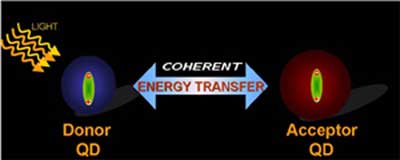| Posted: Feb 21, 2006 |
|
Nanoscience study shows that quantum dots communicate
|
|
(Nanowerk News) Scientists who hope to use quantum dots as the building blocks for the next generation of computers have found a way to make these artificial atoms communicate.
|
|
"Essentially, the dots talk to each other," said Ameenah Al-Ahmadi, an Ohio University doctoral student who published the findings with Professor of Physics Sergio Ulloa in the Jan. 23, 2006 online edition of Applied Physics Letters: "Extended coherent exciton states in quantum dot arrays".
|
|
The dots are tiny, engineered spherical crystals about 5 nanometers in diameter. An average biological cell, in comparison, has a diameter of about 1,000 nanometers. Researchers believe that quantum dots will be extremely useful in developing nanoscale technologies because they are versatile and uniform, which could eliminate possible variations and flaws in materials.
|
|
In the recent study, the researchers were the first to use theoretical models to show how light energy shining on quantum dots would prompt them to transfer energy in a “coherent” fashion. They found that when the dots were arranged a certain distance from each other – greater than the radius of the dots – light waves traveled between the nanocrystals in a consistent pattern. In previous research, the light’s wavelength would change or become irregular during the energy exchange, which creates a breakdown in communication between quantum dots.
|
 |
| Resonant energy transfer is a mechanism for excitation exchange in quantum dot arrays. The researchers explore this process by calculating the coupling strength, and by studying the detailed dynamics of extended coherent exciton states created in an array of quantum dots.(Source: Ohio University)
|
|
The results suggest that there could be a way to transmit information using light waves, laying the groundwork for a possible optical quantum computer. In this device, light energy would replace the electrical charge currently used to transfer information in conventional computers.
|
|
"The idea is to make the (computing) process faster and smaller," said Al-Ahmadi.
|
|
The applications of the new quantum dot technology also could include medical imaging. Quantum dots could be injected into the patient, and a device containing more quantum dots could be used to show the position of dots under the skin. Current biology research has had great success with this type of imaging in mouse models, Ulloa said. The dots have fewer side effects than contrast chemicals used in X-rays, and may eventually replace traditional contrast media.
|
|
Using light energy instead of electricity also would help keep computer temperatures low, as the light energy does not create as much heat as electrical current, Al-Ahmadi added.
|
|
The research was funded by the Indiana 21st Century Research and Technology Fund and supplemented by Ohio University’s Research Priorities Program.
|

